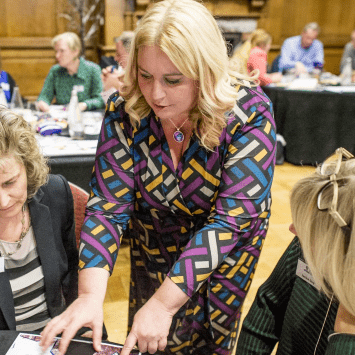Posted in Blog, Design Thinking, Facilitation, Innovation by Jo North
Creative thinking techniques are vital for stimulating innovative ideas and solutions. I love using a variety of them in my creative facilitation to help teams break free from conventional thinking, encourage them to explore new perspectives and ideas and unlock the potential for inventive approaches to challenges.
In this article you’ll learn how and why creative thinking techniques work, when to use them, and how. You’ll also understand different types of creative thinking techniques, and expand your facilitation repertoire.
What are Creative Thinking Techniques?
When we think the way we always think, we end up with the same, predictable answers that we always come up with. Creative thinking techniques are simply activities or exercises that are designed to disrupt our habitual ways of thinking. In doing so, they help us to approach opportunities and challenges from fresh and diverse perspectives, which increases the probability of coming up with a higher number of more novel ideas.
It’s important to remember that ideas come from people, not the techniques. The creative thinking techniques simply help people to have ideas.
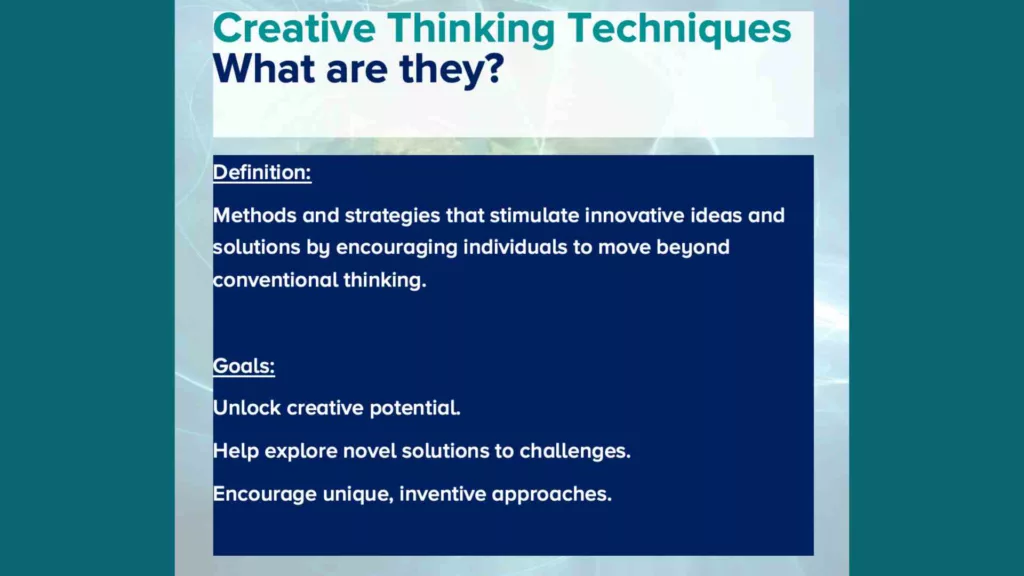
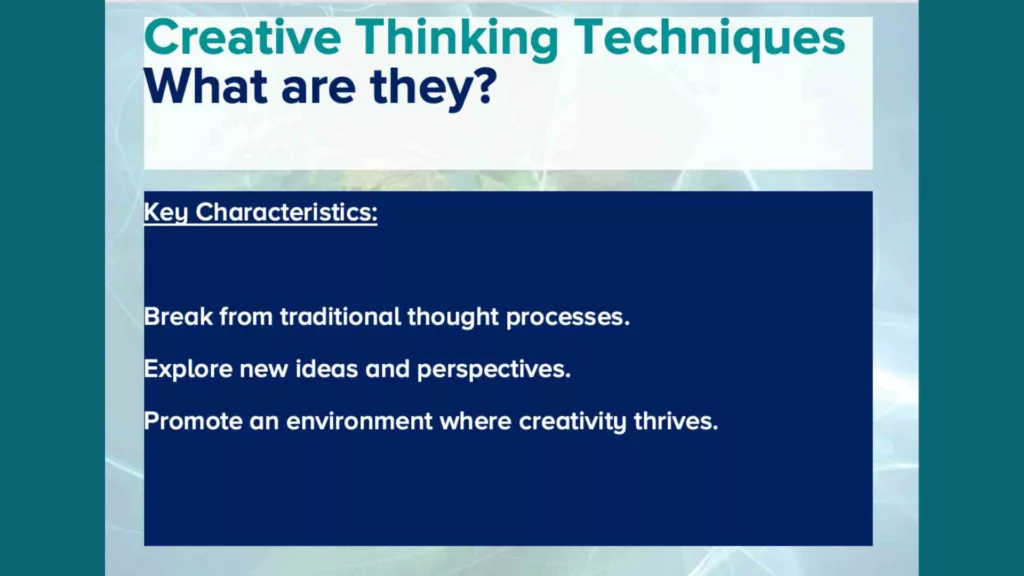
When Should You Use Creative Thinking Techniques?
Use creative thinking techniques for the ideation – i.e. idea generation or brainstorming – stages of your innovation sprint or design thinking workshop. You can then use the outputs from your creative thinking activities to combine or select the most ideas, develop them, and work them through to prototyping or potential implementation.
It’s also a good idea to keep a few creative thinking techniques up your sleeve in case your workshop participants get stuck at any point later on in the sprint.
Keeping creative thinking distinct and separate from analysis and critique. Start by sharing initial thoughts freely, then refine and develop them later, once your creative thinking activities are complete. Evaluating ideas during the brainstorming process interrupts creative flow.
Be mindful of timing. Cycle through ideas, but avoid shutting creative flow off too soon, and rushing to conclusions. Closing off too early can stifle potential.
Incorporate breaks. They’re essential for keeping minds fresh and open to new ideas.
Creative Thinking Techniques: Types and Uses
Here is a facilitation toolkit of my favorite, tried and tested creative thinking techniques, and how to use them.

Not Thinking
It sounds counterintuitive, but ‘not thinking’ can be a powerful technique. You step away from the problem, engage in a different activity, and let your subconscious work on the issue. In workshops, you can facilitate this by introducing breaks or unrelated activities between sessions. Weather permitting, I’ll often ask my delegates to get outside and go for a short walk and talk in pairs. When they come back from their walk, they’ll almost always have a fresh perspective on the challenge at hand.
Creative Questions
Asking the right questions can unlock new ideas. “How might we…?” and “What if…?” open up possibilities. In a group setting, prompt participants to ask these questions in relation to the challenge. This is such a good creative thinking technique that I have written a detailed article with great creative question examples here.
Stretching
This means going beyond the obvious. Push participants to think broader and deeper about the problem and potential solutions. Encourage them to stretch their imagination as far as it can go.
Example Activity Using Stretching: 30 Circles Technique
The 30 Circles technique is a classic exercise designed to push participants to think quickly and creatively. You present a sheet with 30 blank circles on it and challenge each person to turn as many circles as possible into recognizable objects, or fill them with different ideas, within a set time limit, usually three minutes.
How to Use It
- Distribute a 30 Circles worksheet to each participant.
- Set a timer for three minutes.
- Instruct participants to fill in or transform as many circles as they can before the timer runs out.
- Encourage speed to prevent overthinking.
When to Use It
- When the team seems stuck or is overthinking.
- At the beginning of brainstorming sessions to energize participants.
- When you want to emphasize quantity over quality to encourage a free flow of ideas.
Example Activity Using Stretching: The Alphabet Technique
Similar to the 30 Circles, the Alphabet Technique uses letters instead of circles. Participants are asked to come up with an idea related to the project for each letter of the alphabet.
How to Use It
- Provide a paper with the alphabet listed A to Z.
- Give participants a set amount of time to come up with ideas linked to each letter.
When to Use It
- To warm up before more focused brainstorming.
- When you need a broad range of ideas.
Example Activity Using Stretching: SCAMPER
SCAMPER stands for Substitute, Combine, Adapt, Modify, Put to another use, Eliminate, and Reverse. It’s a checklist that prompts participants to think about a product or problem in different ways. I’ve written a detailed article on how to use SCAMPER here.
Exaggeration
By exaggerating aspects of the problem or solutions, you can stimulate creative thought. Ask participants to magnify elements and explore the exaggerated scenario’s implications. For example, ask them to consider what they would do of they had no choice but to achieve the desired outcome in half the time, with one third of the money. You could also challenge your delegates to aim for 10x better results, forcing them to think differently.
Exaggeration Creative Thinking Technique Examples
- Double / treble, quadruple, etc: Scale up something in your problem or idea. For instance, if you’re designing a new car, imagine it’s twice as powerful.
- Halve, quarter, reduce by 75%, etc: Scale down elements. Using the same car example, think about what it would mean if it were half its current size.
- Zoom in and out: Change your perspective. Look at minute details or the bigger picture. If you’re looking at user interface design, zoom in on a single button or zoom out to view the entire user journey.
- Extreme consequences: Imagine the most extreme results of your idea or problem. What if the car you’re designing could go from 0 to 100 mph in 2 seconds? What would that mean for safety, usability, and desirability?
- Extreme user: Consider an unlikely user for your product. How would a child, an astronaut, or a person from the 18th century interact with your modern car?
- Opposite world: Flip everything on its head. If cars are usually designed for speed and efficiency, design one that prioritizes slowness and contemplation.
By exaggerating, scaling, changing perspectives, and considering extremes and opposites, your sprint participants will challenge the usual boundaries and generate innovative ideas.

Force-fitting
Force-fitting means connecting unrelated ideas and objects to the problem. This can lead to creative problem solving and innovative solutions. You can facilitate this using the random stimulus technique – i.e. by providing random prompts and asking how they might relate to the problem. Click here for a step-by-step guide on how to facilitate the random stimulus technique.
Great Force-fitting Activities
Great force-fitting activities that you can use in your innovation sprints and design thinking workshops are:
- Cross-industry inspiration: Look at solutions from other industries and apply them to your problem. For example, if you’re in software development, explore how restaurants design menus and apply similar principles to your user interface.
- Inspired by excellence: Pick a well-known success story and analyze what made it excel. Apply those principles to your challenge. If it’s the reliability of a car brand, explore how to integrate reliability into your product design.
- Constrained brainstorming: Set limitations to your brainstorming process. This could be a time limit, a budget cap, or specific materials to use. These constraints often lead to more creative solutions because they force you to think differently. For example, if you only have a limited budget, how would you redesign a product within that limit?
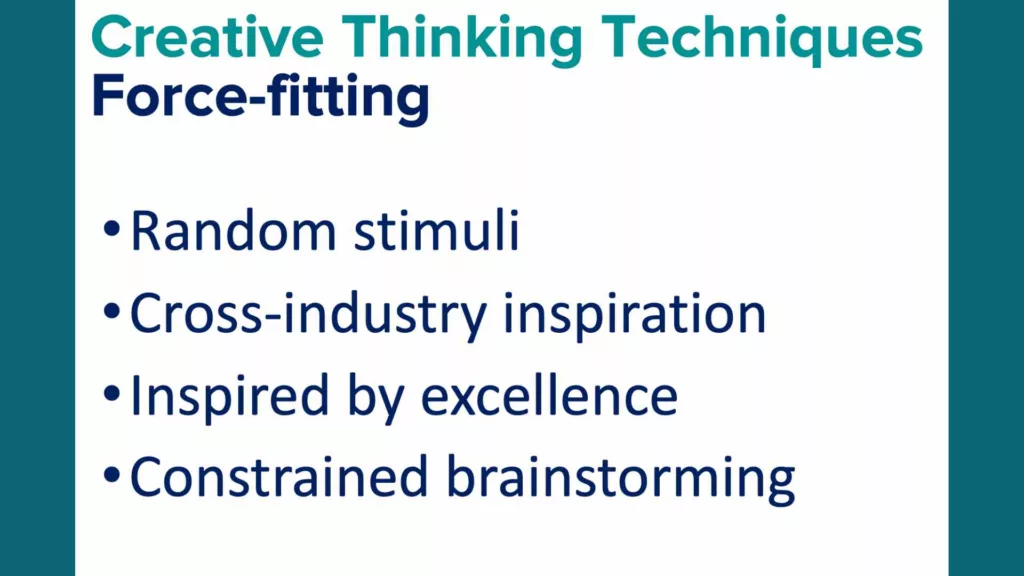
Attribute Listing and Morphological Analysis
Attribute Listing and Morphological Analysis are creative thinking techniques that enhance innovation. These methods break down products, processes, or problems into distinct attributes or components. By analyzing these parts, teams can challenge assumptions and explore new possibilities.

Using Attribute Listing in Innovation Sprints
As facilitator, guide your team to list attributes of a product or process. Then ask them to examine each attribute separately to see how altering it might lead to innovation. This can include changes in size, materials, or function. The key is to isolate attributes and imagine variations without the constraints of existing frameworks.
Applying Morphological Analysis for Deeper Insights
Morphological Analysis is a structured method used to generate new ideas and solutions by exploring the relationships between different dimensions or attributes of a problem. This technique was developed by Fritz Zwicky, a Swiss astronomer, in the 1940s. He used it primarily for scientific and astronomical research to address complex and multi-dimensional problems.
Origin of Morphological Analysis
Zwicky introduced Morphological Analysis while working at the California Institute of Technology. He aimed to systematize the process of examining all possible relationships and solutions in multidimensional, non-quantifiable problem spaces, which he found common in astrophysics but applicable in various fields.
Morphological Analysis Template
Here’s how you might set up a basic template for Morphological Analysis:
- Identify the Problem: Clearly define the problem you want to solve.
- Determine Attributes: List the key attributes, features, or factors related to the problem.
- Develop Variants: For each attribute, list possible variants or options.
- Create a Matrix: Arrange attributes and their variants in a grid. Each row represents an attribute, and columns contain possible variants.
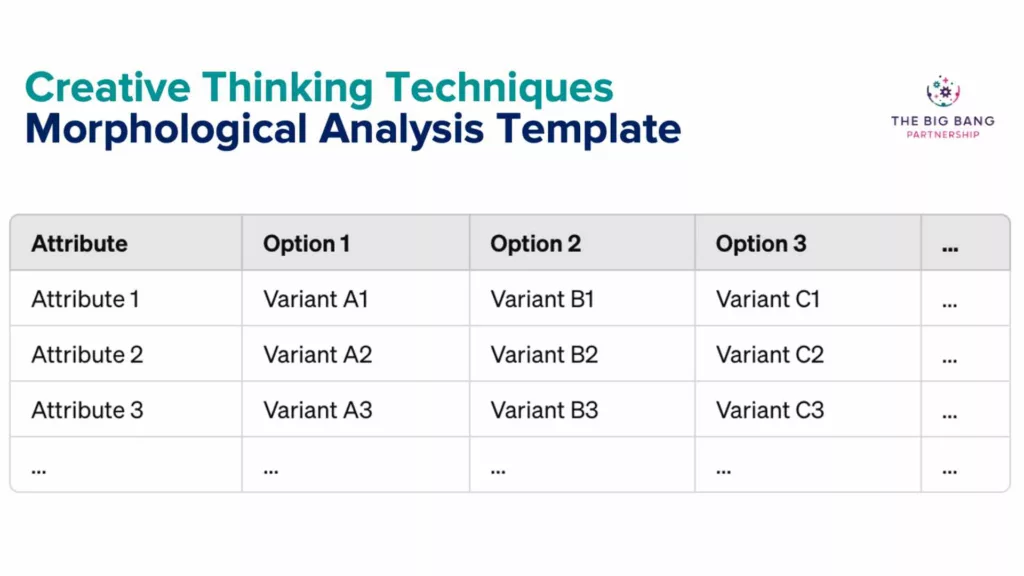
Using the Matrix
To use the matrix:
- Explore combinations of different variants across attributes.
- Evaluate how these combinations might solve the problem or create new opportunities.
This morphological analysis matrix helps visualize potential interactions between different elements, aiding teams or individuals in breaking out of conventional thinking patterns and generating innovative solutions.
Visual and 3D Thinking
Visual and 3D thinking leverages visual aids and three-dimensional constructs to inspire creativity and innovation. Instead of just relying on verbal or written brainstorming, teams build models or diagrams to represent problems or ideas. I find that his hands-on approach improves communication, and unlocks new perspectives and solutions that are not as easily discovered through traditional, linear thinking processes.
Here’s how to facilitate visual and 3D thinking:
- Gather various building materials like blocks, modeling clay, or other craft supplies.
- Present the team with a challenge or problem.
- Encourage team members to construct physical representations of their solutions.
- Discuss the models, focusing on what each one reveals about potential solutions.
By creating a tangible representation of an idea or problem, teams can more easily identify new connections, understand complex systems, and explore spatial relationships. Visual and 3D thinking can be particularly effective for product design, architecture, or any field where the physical form and function are important.
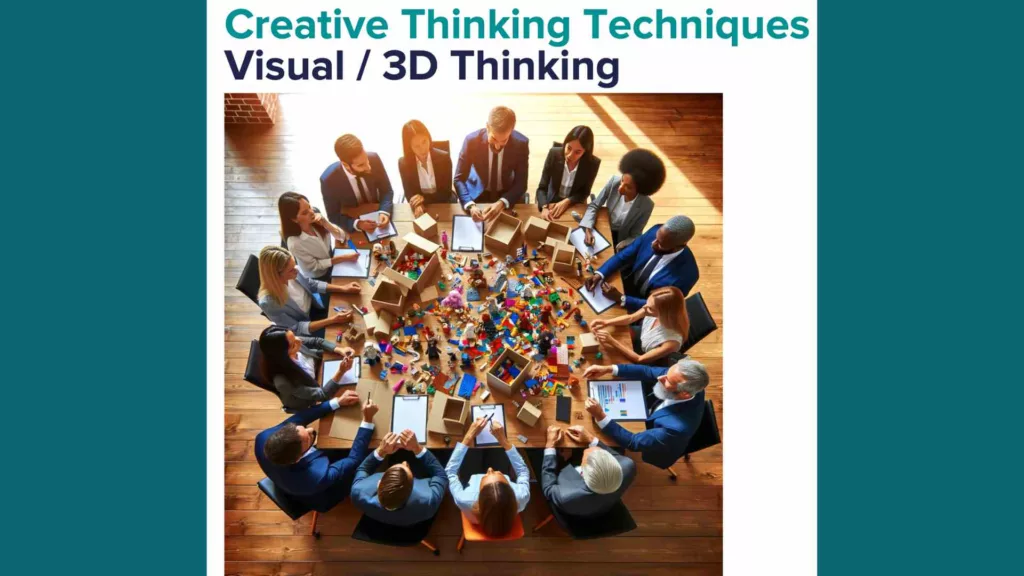
Association – Mind Mapping
Mind mapping, popularized by Tony Buzan, is a visual tool that can help in drawing connections between ideas. Facilitate a mind mapping session by asking participants to write down all thoughts on a problem and then connect related ideas with lines.
Lotus Blossom Technique
The Lotus Blossom technique is one of my favorites, and a great alternative to mind mapping. It is a structured brainstorming approach where a central idea is expanded into themes and further into detailed concepts, visually resembling a lotus flower opening. For a step-by-step guide to using the lotus blossom technique, take a look at my article here.
Combining
Look for ways to combine elements of different ideas to form new ones. Ask workshop participants to merge different concepts to create hybrid solutions.
Lateral Thinking
Lateral thinking, developed originally by Edward de Bono, is a method of problem-solving that encourages looking at challenges from new angles. It involves discarding the obvious, traditional approaches and instead considering alternative and indirect solutions.

Intermediate Impossibles. This involves brainstorming ideas that may seem impossible or impractical. The goal isn’t to find a direct solution but to open up new lines of thought that could lead to viable solutions.
Provocation. Here, you start with a provocative statement or assumption that is intentionally wrong or absurd. This is used as a springboard to explore new ideas by challenging current thinking.
Disproving Assumptions. This method involves identifying existing assumptions about a problem and then systematically trying to disprove them. It can help uncover new angles and opportunities for innovation.
Escape Thinking: You pinpoint the most dominant idea or feature of the current solution and then intentionally discard it. This forces thinking in new directions by removing familiar constraints.
Examples of Lateral Thinking Techniques
Reverse thinking or reverse brainstorming flips conventional problem-solving on its head. Instead of starting with a problem and looking for solutions, you start with the desired outcome and work backward to the current situation. This approach often reveals alternative pathways and hidden assumptions that might block innovative thinking.
In practice, reverse thinking could mean:
- Imagining your product has failed and figuring out why that might happen. This helps you address potential issues before they occur.
- Visualizing the ideal user experience and mapping the steps needed to achieve that experience from the end to the beginning.
This backward approach can open up new avenues for innovation by focusing on objectives and results first, leading to creative strategies that might not emerge from traditional forward-thinking processes.
Reframing
Reframing is a creative thinking approach aimed at looking at situations from a different perspective. Here are some reframing activities that work brilliantly in innovation sprints and design thinking workshops.
Reframing involves changing your perspective on a problem. Facilitators can guide participants to view the problem through different lenses, like from a customer’s point of view or seeing an issue as an opportunity rather than a barrier.
Example Activity Using the Reframing Technique
Objective
Participants will explain a common product or service to someone who has never encountered it before—an alien.
Duration
15 minutes
Instructions
- Introduce the scenario. Tell participants to imagine an alien has landed and is curious about a specific product or service.
- Explain the product/service. Each participant takes a turn to describe the chosen item to the alien without using industry jargon or assuming prior knowledge.
- Discuss what new features or uses did they highlight?
- How did stripping away assumptions bring new insights?
This exercise encourages participants to reframe a product by distilling it to its most fun
Change Problems to Opportunities
This reframing method converts challenges into chances for improvement. For example, when faced with a budget cut, you might reframe it as an opportunity to streamline operations or find innovative solutions that are cost-effective.
5 Whys
By repeatedly asking “why” to each answer (usually five times), you drill down to the root cause of a problem. For example, if a product is failing, you ask “Why?” to the initial reason, then continue to ask “Why?” to each subsequent answer until a fundamental issue is identified.
Role Storming
Participants take on different personas and brainstorm ideas. This can be facilitated by assigning different roles to participants and having them approach the problem from their character’s perspective. For example, if participants adopt the role of a customer, they will think differently than as managers, leading to new insights and ideas.
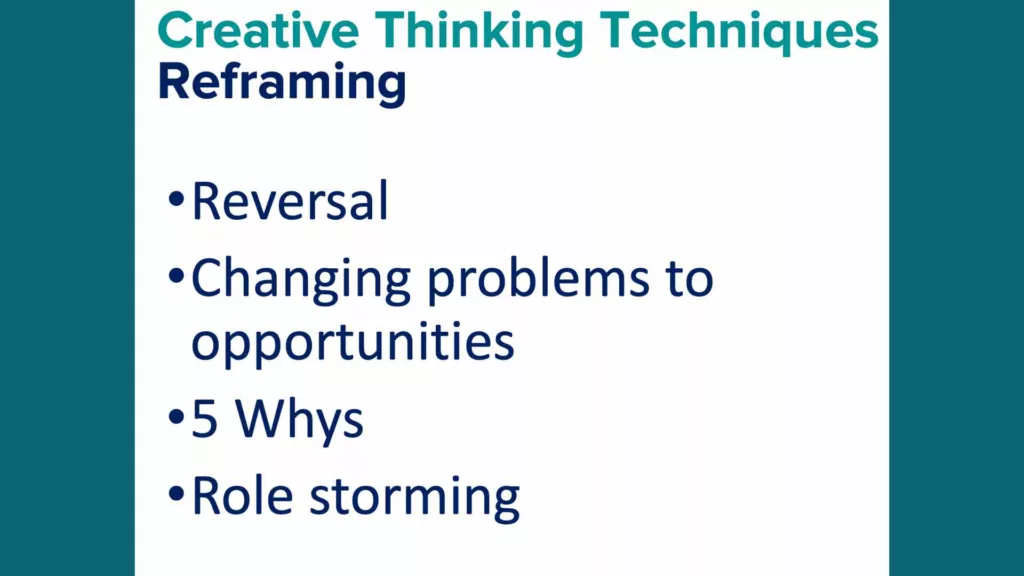
Creative Thinking Technique Tips for Success
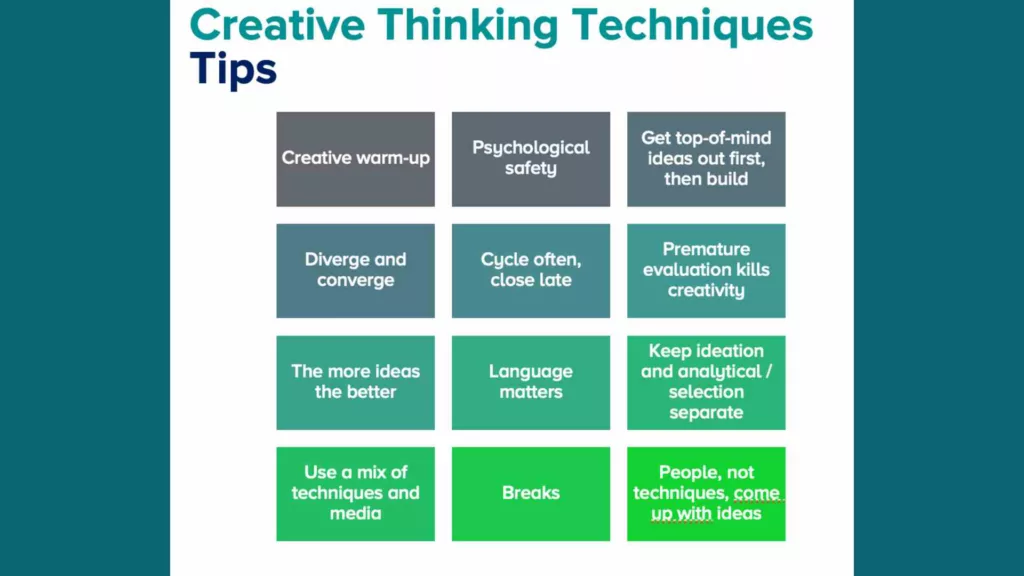
Start Strong
Kick off with a creative warm-up or icebreaker. It will set the tone and get everyone ready to think outside the box.
Build Psychological Safety
To successfully use creative thinking techniques, it’s important to build psychological safety within your design sprint or innovation workshop.
Psychological safety is a sense of people feeling that they can speak up, express ideas, and raise concerns respectfully without worrying about negative judgment or repercussions. Having a psychologically safe environment ensures that all participants feel comfortable sharing their ideas, regardless of how unconventional these may be. As a facilitator, you play an important role in creating this environment.
Establish Open Communication
Set the tone for open communication through your facilitation. This involves explicitly stating that all ideas are welcome and that the goal is to explore various perspectives without judgment. Encouraging everyone to speak and actively listening to their contributions reinforces this.
Structure the Environment
The physical layout of the room can influence how safe your participants feel. Arrange seating to support collaboration and make sure that everyone can see each other and be seen. This setup helps to reduce barriers between participants, promoting a more open exchange of ideas.
Norm Setting
Clear norms can guide interactions within the group. Work with the team to establish rules that promote respect and inclusivity. These might include no interruptions, equal speaking time, and an emphasis on constructive feedback. Make these norms visible throughout the session so that people have a constant reminder.
Be a Role Model
Lead by example to encourage desired behaviors. This includes showing vulnerability, such as sharing your own ‘half-baked’ ideas and thoughts without self-censorship. Demonstrating openness to feedback and making adjustments based on group input can also strengthen this safe space.
Build Trust
Trust builds over time, but you can accelerate the process. Quick warm-up, icebreaker and team building exercises that allow personal sharing can help. Also, facilitating small group discussions and using breakout groups early in the workshop can promote closer connections among participants. This makes it easier for people to share more freely in the larger group later on.
Use a Variety of Techniques
Using diverse creative thinking techniques and media enriches the creative process. Strategies like brainstorming, using visual and 3D thinking, and engaging in activities like ’30 Circles’ can spur creativity. Moreover, techniques like force-fitting, where unrelated concepts are combined, and attribute listing, where elements are broken down and reconfigured, can lead to surprising and innovative outcomes.
Creative Thinking Techniques in Action
An Essential Skill-set
Creative thinking skills are an essential skill-set, vital for personal development and generating ideas that lead to new products and innovative solutions. Divergent thinking, the ability to consider different perspectives, and an open mind to the ideas of others form the basis of generating novel solutions. Engaging a group of people from different backgrounds in a brainstorming session is a great way to unlock the unconscious mind and allow for the generation of ideas that can lead to the most original idea. By stepping out of their comfort zone and considering different points, creative thinkers can harness their natural creativity and apply selected approaches to transform an initial idea into a suite of possible solutions.
Disrupt Habitual Thinking
Using random words or imagery to stimulate the creative juices can be an effective method to generate fresh ideas, especially when looking at problems from different angles for the first time. The power of several minds working together can assimilate large amounts of information, leading to the creation of new things. The application of brainstorming tools is an effective way to tap into innate creativity and foster the essential skills necessary for innovation.
Get Visual
To bring a new perspective into a group activity, it’s helpful to capture ideas on paper, which can lead to fresh angles and a selection of behaviours that can spark the most creative projects. Creative thinkers understand that great ideas often begin with viewing the problem from new ways and embracing the best ideas that emerge from different levels of thought.
Bring an Open Mind
The generation of ideas through popular creative techniques not only enhances innovation skills but is also the best way to develop effective innovation techniques. This kind of open-mindedness is crucial for new experiences, fostering the best ideas and bringing great ideas to fruition. Keeping a curious mind during creative activities is an important element of innovation, as it ensures that even while exploring new creative ideas, people remain grounded in finding practical and actionable new solutions.
Creativity at Work
Ultimately, the natural creativity of individuals, when refined and applied through creativity techniques, becomes an important part of their own work, allowing for the production of new products and novel solutions in different situations. The basic principles of creativity, combined with effective innovation techniques, are an important part of any innovation skill set on an individual level.
Next Steps
Creative thinking techniques are indispensable for innovation. They provide the tools to break away from traditional thought processes and explore groundbreaking ideas. By fostering an innovation climate that promotes creativity and by employing a range of techniques, as facilitator you can help your team to unlock more of their creative potential.
Ready to elevate your innovation sprints and design thinking workshops? Get in touch with me here for expert facilitation, guidance and coaching on implementing creative thinking techniques that drive results. Let’s collaborate!

